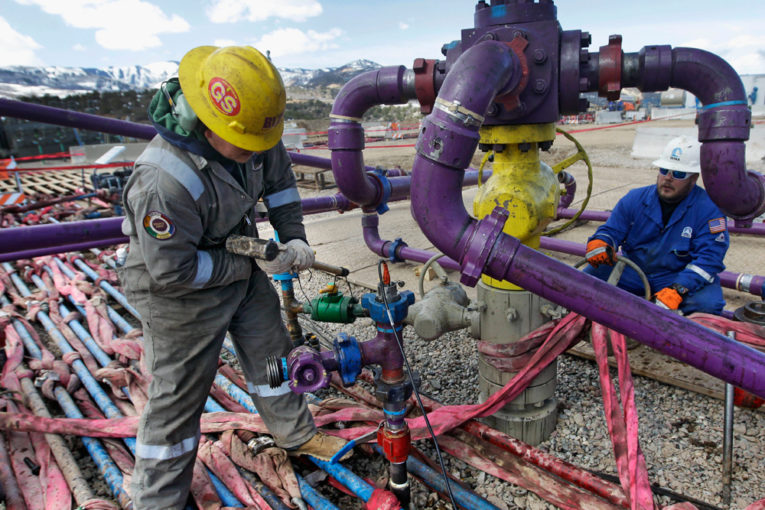
In the Western Alberta town of Fox Creek, roughnecks shuffle through hotel lobbies, freight trucks choke slushy streets and, every once in a while, tremors shake the earth.
Welcome to Canada’s biggest shale boom. Chevron Corp., Royal Dutch Shell Plc, Encana Corp., Murphy Oil Corp. and XTO Energy Inc. are among those flocking to Fox Creek to stake their claim in the oil-rich Duvernay shale formation.
Here, the prize is condensate, an ultra-light oil that’s perfect for diluting the heavy tar-sands crude for which Alberta is known. More locally produced diluent would be a plus for Canadian companies that now depend on the U.S. — and for communities like Fox Creek that are feeling the economic benefits along with fracking-linked earthquakes. More of both may be in the offing as drillers flock in Chevron’s wake into the Duvernay region.
“They are talking about thousands of new wells up there, not just Chevron, but all of them,” Mayor Jim Hailes said during an interview in his office. “The play is that big.”
Oil and Gas Boom
Domestic companies use around 600,000 barrels of condensate a day, and production of the hydrocarbon in Alberta is surging. Output reached 64,000 barrels a day last year, the highest in provincial production records dating back to 2010. In the Duvernay, oil and gas output is poised to more than triple in the next two years to the equivalent of 300,000 barrels of oil a day, according to Stephen Kallir, upstream research analyst at Wood Mackenzie in Calgary.
The pace of activity is only getting busier after Chevron, which owns the most drilling rights in the area, announced plans to develop about 55,000 acres (22,000 hectares) of land in the so-called East Kaybob section of the Duvernay, near Fox Creek. Other companies are expected to follow suit, Hailes said.
Mixed Blessing
The Kaybob section already holds 80 per cent of Duvernay wells and accounted for 90 per cent of the formation’s production, according to an October BMO Capital Markets report. The majority of the play can be economically produced for US$55 a barrel, Wood Mackenzie’s Kallir said.
That’s a mixed blessing for Fox Creek, Mayor Hailes explained as he drove his Toyota Highlander through the town, pointing to the fruits of the area’s newfound fortune. On the left is a new US$8 million fire house. To the right, a US$32 million recreational centre and multiplex are going up. Farther down the road are new ski trails and a bicycle track.
On the other hand, drilling has been so intense near Fox Creek that it’s been linked to a series of earthquakes. One tremor measured 4.6 in magnitude, one of the two biggest human-induced seismic event in Canada’s history, Honn Kao, research scientist at the Geological Survey of Canada, said by phone. Madrid-based oil producer Repsol S.A. took responsibility for that one, telling Bloomberg that the quake was triggered by its hydraulic fracturing operations in the area.
As a result, the company has put into place protocols to mitigate quakes, Berta Gomez, a spokeswoman, said it an email.
Quake Fears
Local concerns about the quakes prompted Chevron recently to alter plans to drill two horizontal wells right under the town, which is thought to sit right over the Duvernay’s “sweet spot.”
“Chevron takes the concerns of residents seriously,” Leif Sollid, a company spokesman, said in an email. “This area is assessed as a lower risk region within the Duvernay for induced seismicity, and any related events would be feeble to slight in nature.”
Other worries, according to Hailes, include the thousands of trucks that pass down the highway each day, some of them spilling their cargoes of fine sand integral to fracturing wells. Meanwhile, the work camps that surround Fox Creek sometimes house almost five times more people than the town itself, putting pressure on local resources such as the hospital and fire department, Hailes said.
“When I, as a resident, pay taxes, go to pick up a prescription, the line is out the damn door,” Brenda English, a realtor with RE/MAX Advantage and resident of the town since 1975, said in an interview from her office. “It’s insane.”
Still, the Duvernay’s promises are too good to ignore. First explored in 2011, the formation holds the equivalent of 25 years of Alberta’s natural gas production and 17 years light oil and condensate output, according to Canada’s National Energy Board.
“The term they are using is a ‘generational play,’” Hailes said.
Bloomberg.com
You can read more of the news on source
